Fresh after their 2-0 win at home against Heracles, AZ Alkmaar faced Manchester United in their latest UEFA Europa League clash on Thursday. Unlike the hosts, the guests failed to get a win in their last league game, drawing 1-1 against Arsenal at home.
Facing against AZ Alkmaar who may seem to be a team of smaller stature, many Manchester United fans were very much expecting their team to score the full three points at AFAS Stadion. Clearly though, it was not going to be an easy task for Manchester United as they’re facing a currently in-form AZ who have been very sharp and solid in all competitions that they’re in.
This was a game brimming with exciting talents with both sides displaying a number of young prospects in their starting lineup.
Let’s take a closer look at how both team’s fared against each other in this tactical analysis.
Lineups

AZ (4-2-3-1)
Dutch coach Arne Slot deployed his team in his favourite 4-2-3-1 system in this match. There were three changes of personnel in this game with Ron Vlaar coming in for Pantelis Chatzidiakos, young right-back Yukinari Sugawara starting ahead of Jonas Svensson, and Albert Gudmundsson being relegated to the bench for wonderkid Calvin Stengs.
Starting XI: Bizot – Sugawara, Vlaar, Wuytens, Wijndal – Midtsjø, Koopmeiners – Stengs, de Wit, Idrissi – Boadu
Bench: de Boer, Chatzidiakos, Ouwejan, Clasie, Reijnders, Aboukhlal, Druijf
Coach: Arne Slot
Manchester United (4-2-3-1)
Ole Gunnar Solskjær used the same formation of 4-2-3-1 again in this game, having used the same system in their last match against Arsenal which ended in a 1-1 draw. Solskjær really rotated his squad for this game with eight changes of personnel in his team for this game. Only David de Gea, Victor Lindelöf, and Daniel James maintained their spot in the starting 11.
There seemed to be quite a lot of youngsters involved in this game. Diogo Dalot took the right-back spot from Ashley Young, Marcos Rojo started ahead of towering defender Harry Maguire, young left-back Brandon Williams saw his name in the teamsheets – replacing Axel Tuanzebe, Both Fred and Nemanja Matić started – relegating Scott McTominay and Paul Pogba to the bench.
In attack, Jesse Lingard, Andreas Pereira, and Marcus Rashford were all warming the bench while exciting prospects Mason Greenwood and Angel Gomes, as well as highly-experienced Juan Mata, got into the starting lineup.
James, who’s usually being played in wider positions, was given the task to play as the striker in this game. Quite interesting choice from Solskjær considering he also has Greenwood who’s capable and perhaps a bit more familiar in playing in a more central role upfront.
Starting XI: De Gea – Dalot, Lindelöf, Rojo, Williams – Fred, Matić – Greenwood, Mata, Gomes – James
Bench: Romero, Maguire, Tuanzebe, McTominay, Lingard, Rashford, Chong
Coach: Ole Gunnar Solskjær
AZ Alkmaar’s solid defence was Manchester United’s weakness
Though Manchester United’s lack of cunning, creativity, and urgency up front was one of the reasons why they’re really struggling to break through AZ’s defence and score despite having a decent amount of possession, AZ’s highly-disciplined and extremely well-organised defence was surely the most defining factor.
AZ aimed to annoy Manchester United in their initial build-up phase. They formed a high block, pushing Manchester United’s forwards to move deeper while also forcing their backline into a mistake as well as blocking their access to the centre via tightly marking Fred/Matić.
With Manchester United tending to distribute the ball short towards either of the two centre-backs from the goalkeeper, Myron Boadu attempted to close down the ball-carrier – aiming to force him to move the ball towards the flank where they could create an overload and isolate him – whilst also blocking his access towards his partner which effectively split the two centre-backs. Manchester United were often forced to launch a long-ball forward due to this. However, they’d more often try to direct their long balls diagonally towards the other flank rather than launching it vertically where they’d have very little chance of winning the first ball. Occasionally, they’d also try to launch a long ball towards the space behind AZ’s backline, but those passes more often than not ended in failure.
AZ’s successful pressure would happen when Manchester United didn’t have proper support at the back.
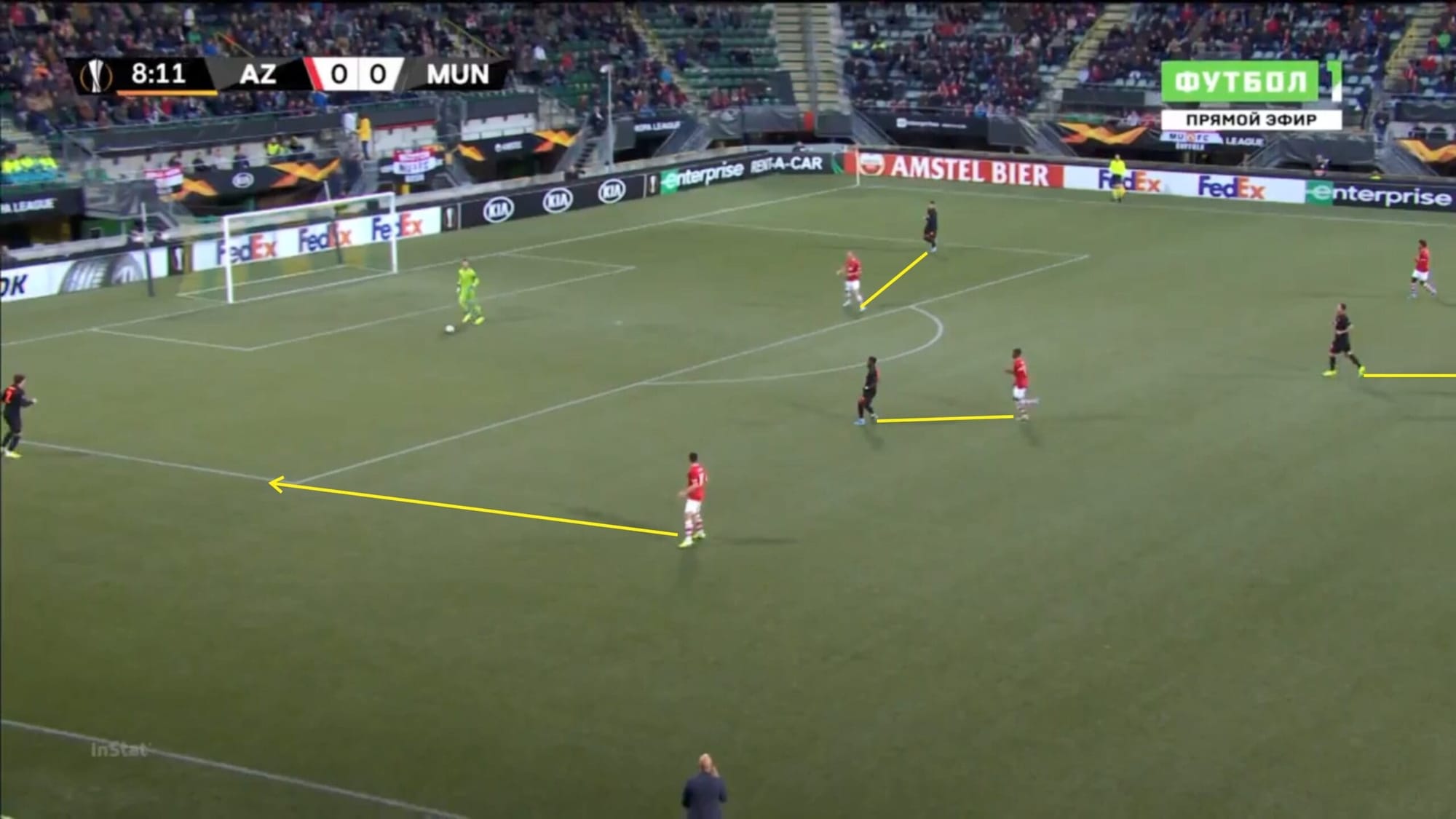
As you can see in the picture above, Boadu and Dani de Wit switched roles with De Wit pressing the backline and splitting defenders while Boadu marked Fred. Matić was also marked by Midtsjø who was not in the frame. The high and wide positioning of Manchester United’s full-backs meant that the centre-backs would usually split further and be more prone to losing the ball in such a dangerous position due to the lack of support and high pressure from AZ.
With the short options also blocked, Manchester United were also often forced to loft the ball forward. In the picture above, although De Wit could have closed De Gea down while blocking his access to Rojo, the former Ajax man didn’t do it and decided to stay in his place, giving time for De Gea to control the ball and redistribute it. Manchester United lost the ball anyway merely seconds later after the long pass from behind eventually found nobody upfront.
Despite blocking high and pressing aggressively in their opposition’s initial build-up phase, AZ would drop deeper if Manchester United managed to get past their pressure – often defending with 10 men behind the ball.
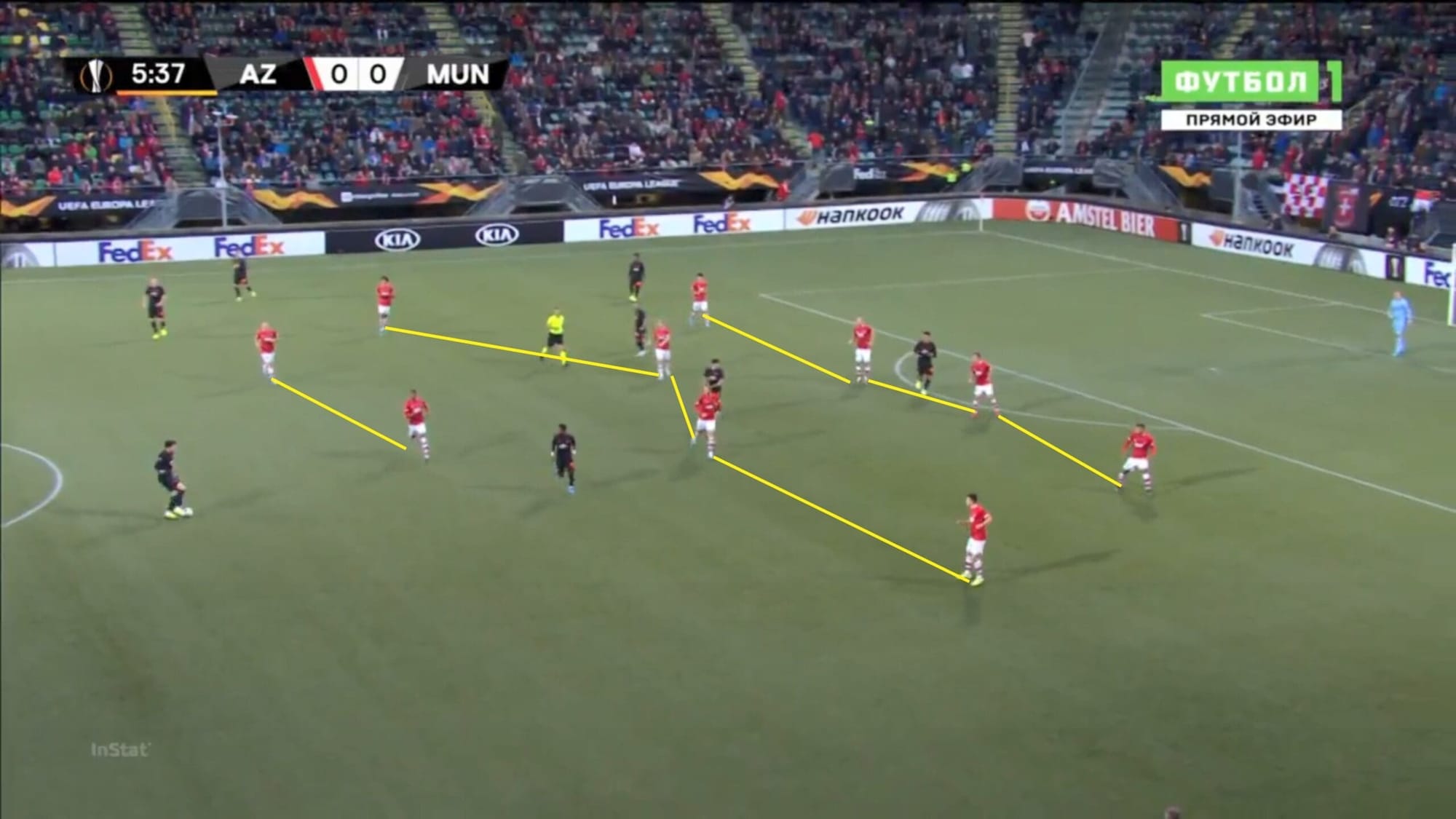
AZ maintained their compactness by dropping deep and defending in a low block once Manchester United successfully got past their frontline pressure. They formed a defence with a compact two banks of four in a 4-4-2 shape. This happened on a consistent basis throughout the game. AZ’s deep and compact block considerably reduced Manchester United’s threat in attack, which was apparent with the English side failing to find space to attack/move the ball into space to progress or create a chance around the final third.
In the end, Solskjær’s men seemed stuck in the middle despite managing to escape AZ’s pressure – just moving the ball around (mostly laterally rather than vertically), often also forced to play the ball back and restart their attack.
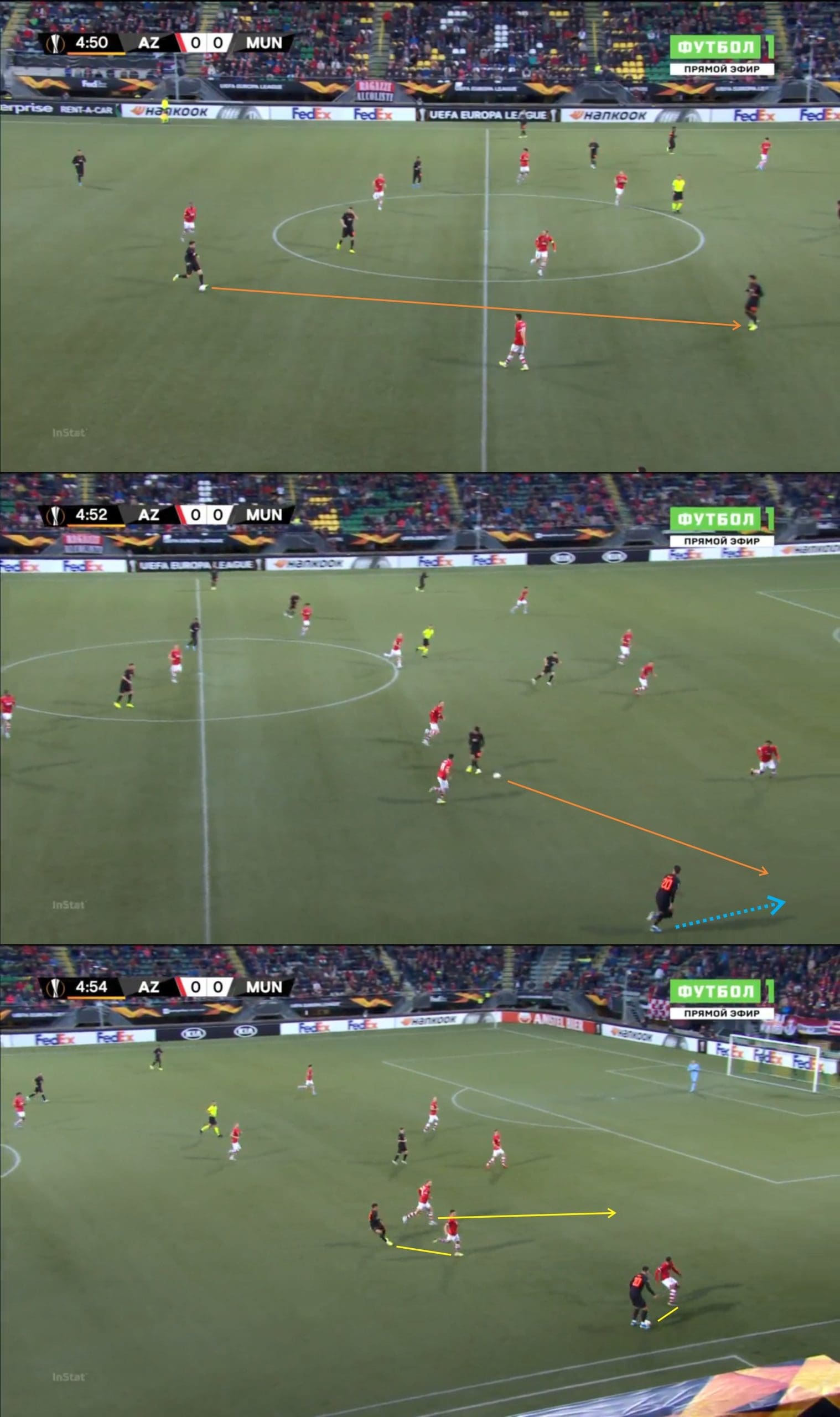
In the sequence of pictures above, Manchester United managed to successfully play out from the back and break forward. Gomes played the ball backward diagonally towards Lindelöf after failing to find a teammate or space to progress. The latter then drove forward with the ball and then found Greenwood in a pocket of space in the half-space. The winger then continued the ball to the wing where there was Dalot sitting near the touchline, asking for the ball into space in front of him. However, Manchester United was clearly outnumbered out wide.
In the last picture above, we can see that Oussama Idrissi tracked back to help out the defence. The talented winger marked Greenwood, blocking the access to him which left Dalot in a 1v1 situation against Owen Wijndal. Meanwhile, Teun Koopmeiners covered the space left by Wijndal, anticipating if the Portuguese full-back successfully got past Wijndal or if he’s looking to play a through pass towards James – however, the Englishman stayed central in this situation.
Dalot eventually managed to successfully take on Wijndal but lost the ball in the end with Koopmeiners winning the ball and then putting it out for a throw-in. The same defensive tactics can also be seen on the other side of the flank with the full-back engaging in a 1v1 defensive challenge, winger blocking access to the centre or half-space, and the central midfielder dropping into defence, covering the full-back’s spot.
AZ’s discipline and organisation in executing the defence – quickly switching from a high block to a low block as well as creating an overload on one side of the flank and then swiftly moving the block to create an overload on the other side of the flank – was fantastic.
Both teams’ way of breaking forward
Both teams had a different approach when in possession despite some similarities. Both AZ Alkmaar and Manchester United did start their build-up from deep with short distribution towards the centre-back from the goalkeeper, preferring to play their way out of pressure from the back although often being forced to play long balls under pressure.
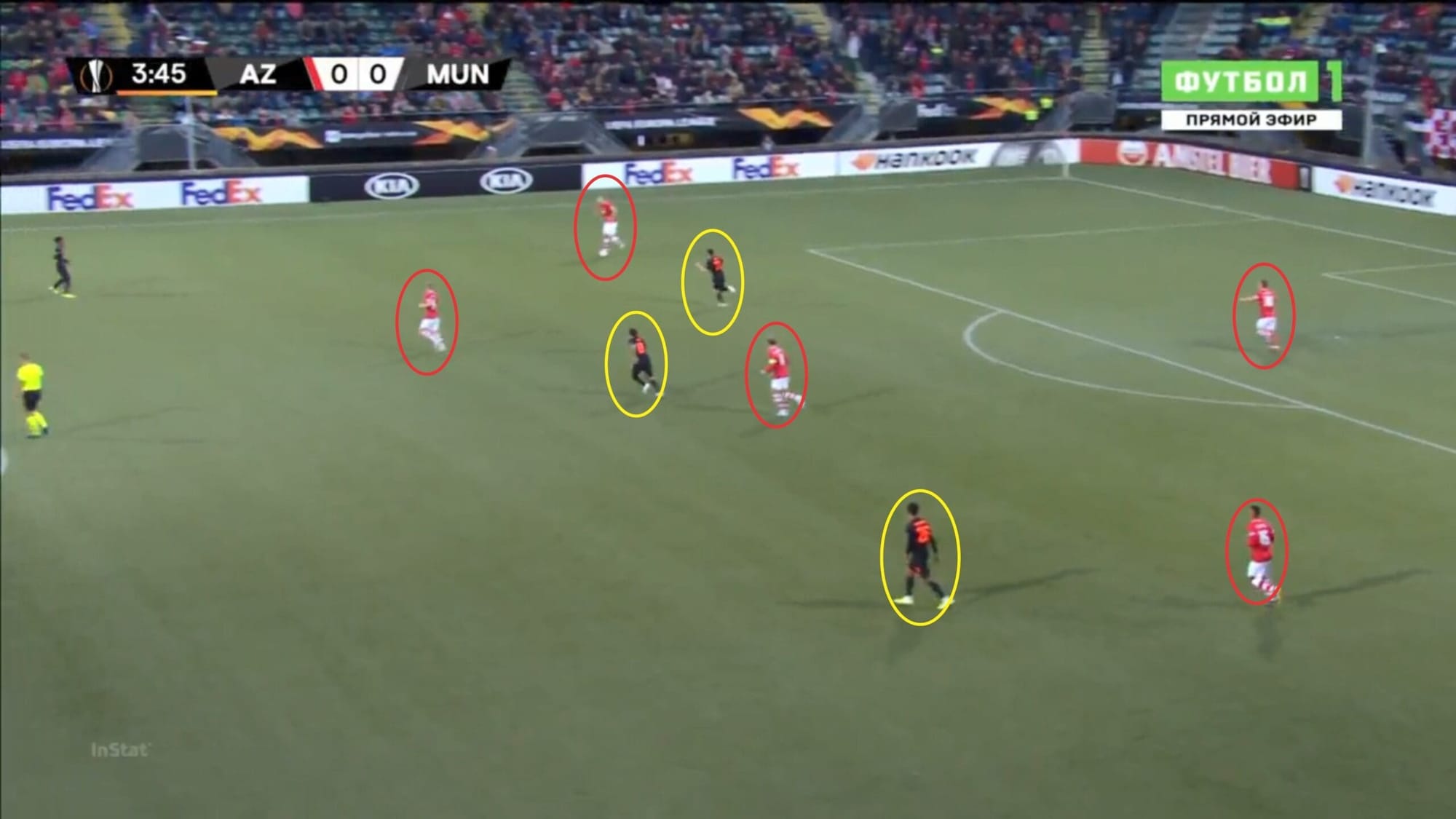
However, the clear difference was that AZ were much more patient in their build-up. Although having to endure heavy pressure from the quick and energetic Manchester United frontline, AZ were often still rather comfortable playing at the back with six players usually involved in the initial build-up phase: the goalkeeper, one full-back, two centre-backs, and two central midfielders who dropped deep and stayed close to offer support. One of the three forwards would occasionally also drop deep, usually sitting in the half-space to add to the number.
With Manchester United effectively being outnumbered, AZ could move the ball around with few problems. Later in the game though, Manchester United seemed to increase the intensity of their pressure, often involving the full-backs as well as the central midfielders to push forward and press as well as mark man for man in order to really cause some problems in the build-up phase of AZ. This often left some space at the back of Manchester United’s defence though and they were often exploited by AZ who broke forward with pace. This can be seen in the picture below.
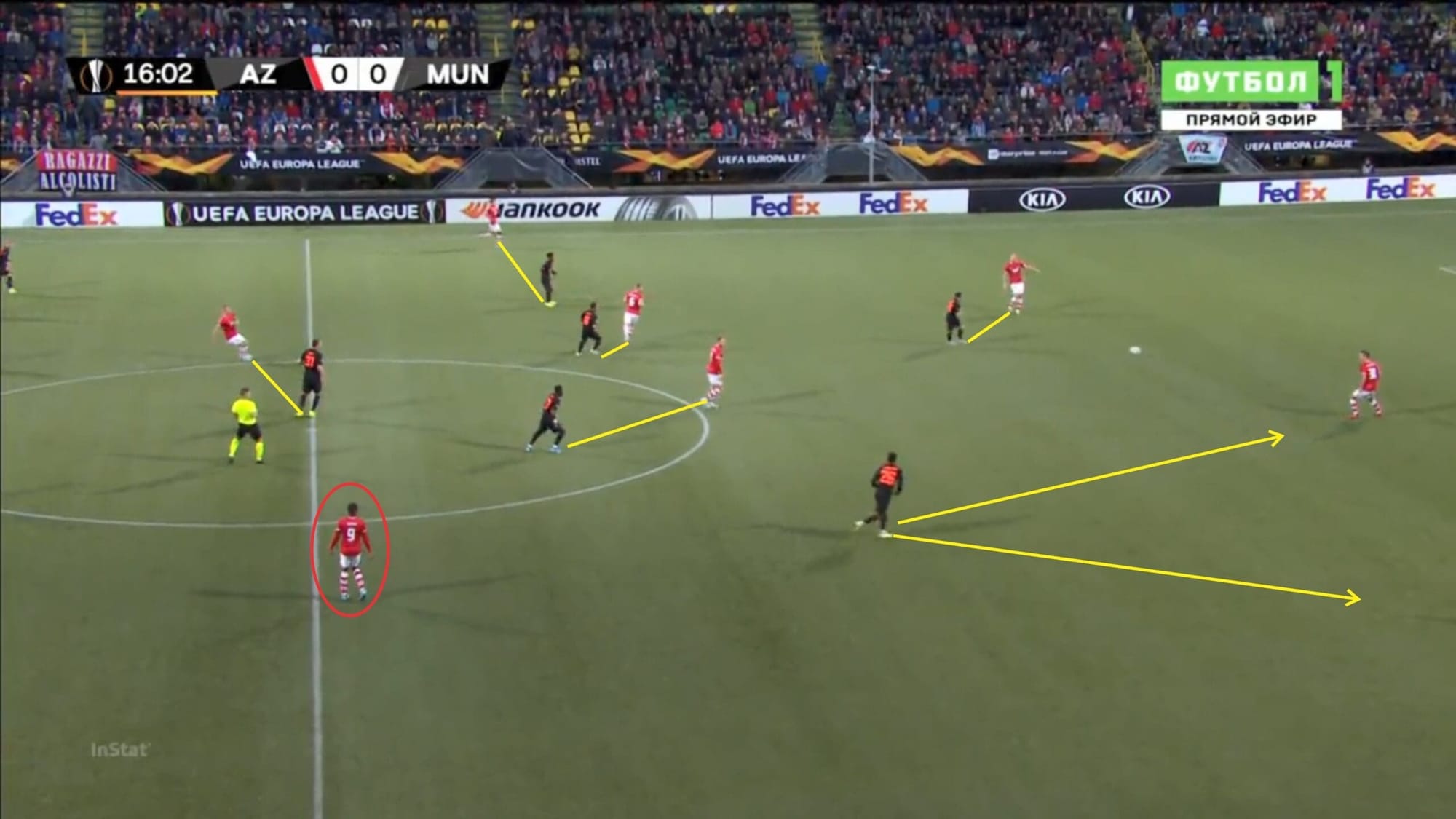
A bit different than AZ’s way of pressing the backline, James tended to close down the ball-carrier by coming in front of him rather than from his side which could have blocked the ball-carrier’s passing lane towards his partner. In the picture above, we can also see that Boadu dropped below the halfway line, sitting in the half-space, freeing himself from any marker and offering a passing option there. With Idrissi still sitting high, Dalot was occupied and could not close down Boadu when the ball was played towards him. Fred was also very much concentrated in marking Koopmeiners tightly and was too late to intercept the ball towards Boadu.
Stengs were also playing in a rather unique way in this match. He’s much more often found playing closer to the centre rather than out wide. A bit different than Idrissi who also cuts inside quite often, but still stretches the defence by staying wide too.
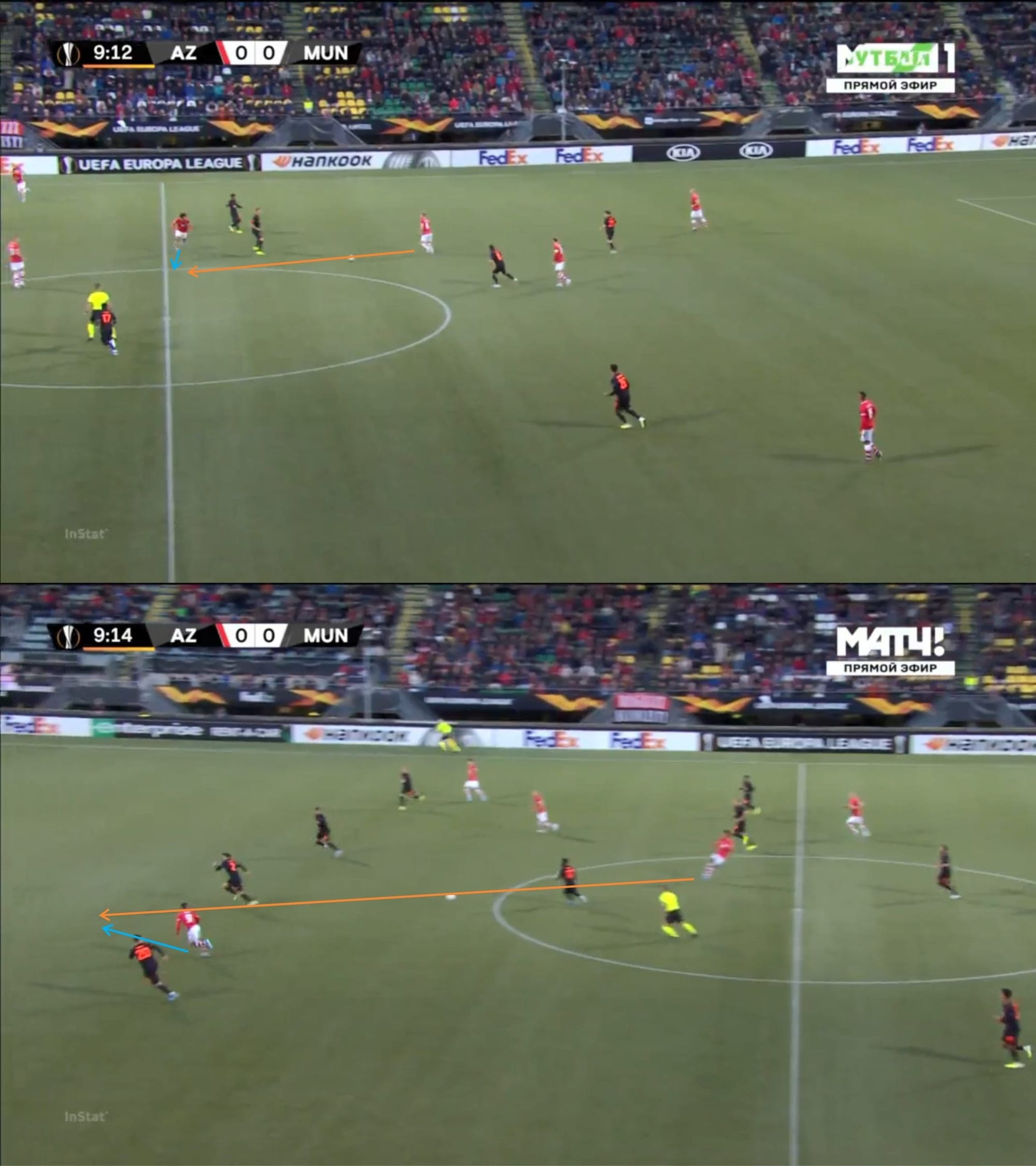
Stengs let Sugawara attack the right flank, occupying Williams, meanwhile he would drop close to the halfway line in the half-space, or event right in the middle at certain occasions and ask for the ball. He’d then deliver a diagonal ball either towards space out wide for Idrissi or onto the path of Boadu who’d usually play off the shoulder of Lindelöf and make a run into space behind his back. Different than Idrissi who were very rarely seen attempting the same thing, but rather would often receive the ball around the final third and cut inside to take a shot or a cross or give the ball through towards Wijndal who’d make an underlapping/overlapping run.
Despite playing quite patiently at the back, AZ tended to increase their urgency upfront, usually playing with short passes and increasing the tempo of their passing exchange by playing with only one or two touches.
Manchester United, meanwhile, were the opposite of AZ. They seemed to be a bit more rushed to get the ball out of defence, moving the ball up rather quickly and seemingly going forward with a bit more urgency compared to their opposition. However, their advances seemed to stop abruptly once they’ve got past the halfway line.
With AZ quickly forming a deep block once Manchester United escaped pressure and exited their own half, the Manchester-based side were having difficulties to break through AZ’s extremely solid defence but their lack of pace when moving the ball, switching play, and rotating positions were not helping either.
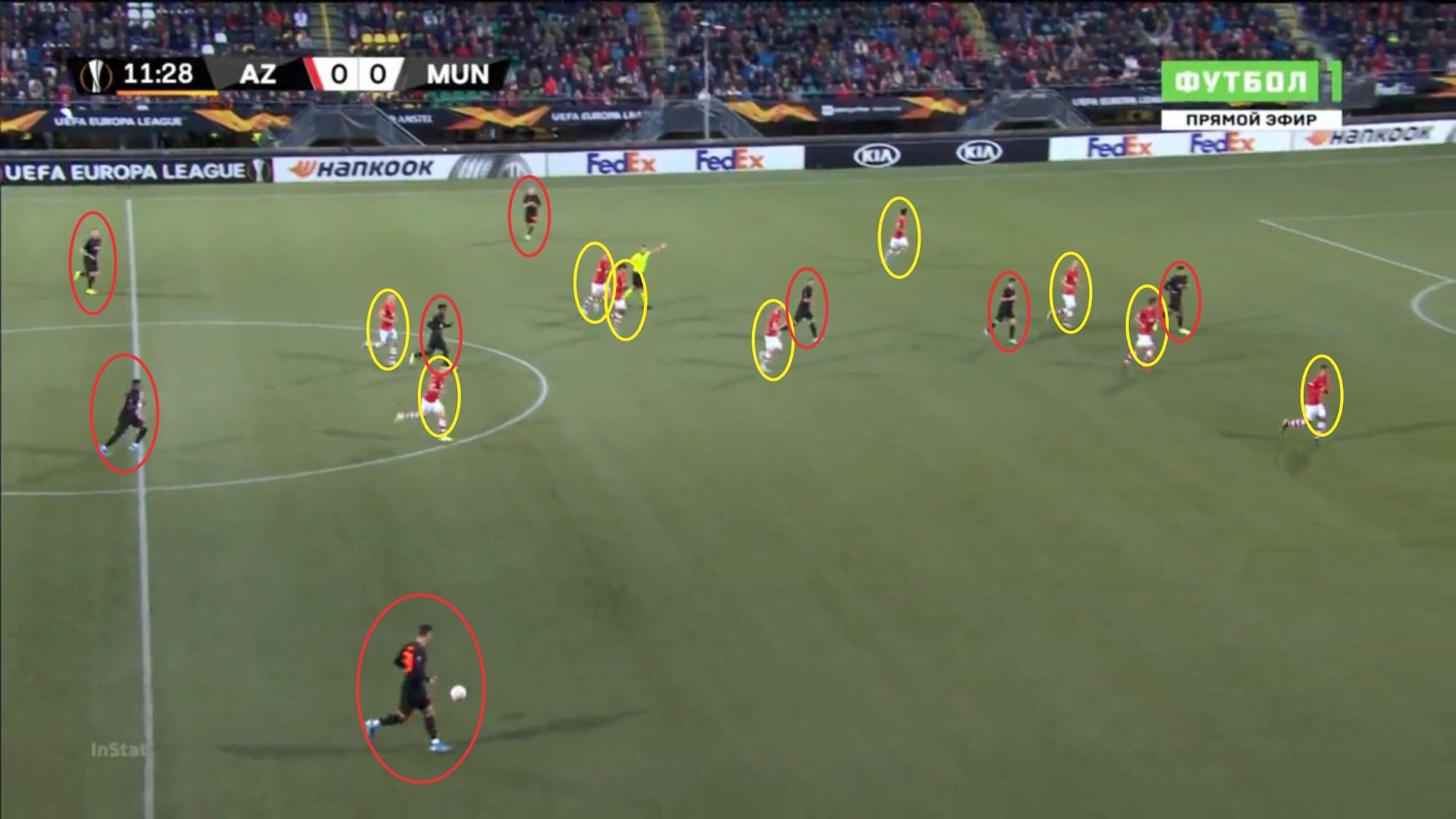
The picture above shows how quick AZ were in their transition from attack to defence, while Manchester United were definitely not quick enough. In this situation, Manchester United won the ball back inside their box and broke forward through the left flank. AZ, as mentioned before in this tactical analysis, immediately pressed the ball-carrier to force him into a mistake and make it difficult for him to break forward – rendering Manchester United to be slower when on the counter and giving time for his teammates to recover to their position.
In the picture above, AZ players were trying to keep their middle compact and crowded while giving pressure to Gomes who was trying to switch the play to the other side of the pitch. Some players were also still recovering back to their own position which was why there was some space on the flanks. However, AZ successfully slowed down Manchester United’s attacking transition in here and they managed to get nine men behind the ball minus Boadu, meanwhile barely got six men above the halfway line with the other two still trailing behind.
Conclusion
AZ showed solidity in their defence, while Manchester United, though they managed to keep a clean sheet in this game may not be so lucky in another day. Both sides were no doubt filled to the brim with exciting talent and players with the potential to be special. However, in terms of tactics, AZ perhaps should be the winners of the game.
Manchester United surely could have performed better. In this game, there were certain moments of brilliance created by their young guns, but unfortunately too inconsistent to really trouble a strong AZ defence. Misplaced passes (or perhaps terrible) and miscommunications seem to also be happening a few times in the game throughout the full 90 for Manchester United and though this may seem normal as, of course, humans do make mistakes – this lack of concentration could also cost them dearly in another day.
Overall, it was pretty much a substandard performance by Manchester United who were the bigger team and the favourites to win the game and a job well done by AZ, who although failed to get the full three points, still managed to keep Manchester United from scoring a goal and even cause some trouble along the way throughout the game.

If you love tactical analysis, then you’ll love the digital magazines from totalfootballanalysis.com – a guaranteed 100+ pages of pure tactical analysis covering topics from the Premier League, Serie A, La Liga, Bundesliga and many, many more. Buy your copy of the September issue for just ₤4.99 here





Comments